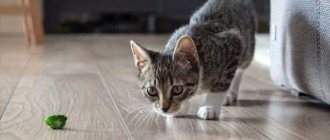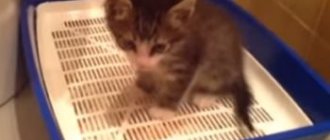Anyone can have a cat, but not everyone can tame one. Despite his cute appearance, he does not lose his natural instincts and strives to show this in every way. In such a situation, it is important to understand how to get the cat to stop marking his territory. You should start thinking about this question by 7-8 months. The kitten has already become a fully mature individual and shows by its behavior that it is the master of the house.
Sometimes an adult cat marks his territory to express his resentment or jealousy, for example, because he was yelled at, or because there was another person or animal in the house. Otherwise, the pet strives to attract attention or shows that it needs a cat. However, the legend that a cat will mark before the first mating often turns out to be false. In most cases, it continues to upset its owners further, leaving an unpleasant odor on clothes and in the corners of the house.
What is a territory marker and why is it needed?
Cats begin to mark their territory regardless of the cleanliness of the litter box or the desire to go to the toilet. The marking process itself is different from urination, where the pet sits down slightly to do its job. The cat marks its territory as follows:
- the pet approaches the selected place backwards;
- raises the tail and vibrates it sharply;
- emits a stream that has a very pungent odor.
Usually the cat marks clothes and shoes, which is why you often have to throw things away, since it is extremely difficult to remove the smell. Equally common is the marking of vertical objects, such as furniture and doors.
The composition of the liquid released to mark the territory differs from regular urine. It contains uric acid crystals, which give such an unpleasant odor. The aroma becomes stronger if the animal marks the same place repeatedly.
© shutterstock
Toilet whims: a pet marks because of an uncomfortable toilet
- The smell in the tray. Some animals refuse to go into the litter box if it is already dirty. The most impatient of them begin to mark.
- Uncomfortable toilet. The cat may not like the location of the tray, for example, if it is in an insufficiently secluded place.
- The tray is too big or too small. The dimensions of the tray must correspond to the size of its visitor.
- The owner's attempts to forcefully keep the cat in the toilet.
For those who suspect that their cat has started marking due to an inconvenient toilet, we will tell you how to place your mustachioed friend in his litter box.
Reasons that make cats mark territory
When buying a kitten, it is difficult to understand how it will behave in adulthood. In some cases, he behaves correctly, and only the tray has to be cleaned, and in others he shows who is boss in the house, even if he has never marked the territory before. Typically, this problem occurs in most cases when the pet is 7 months old and wants a female. However, even after achieving your goal, the problem of marking vertical surfaces and things often remains relevant.
Many animal owners solve the problem of excessive sexual activity by castration.
Its essence is to remove the animal’s genital organs (testicles). The procedure is performed mainly at a young age (up to 12 months) under local or general anesthesia. It lasts no more than 15 minutes, after which the pet can be taken home. Such operations are something scary for many owners, but with their help the pet becomes more obedient. Veterinarians recommend carrying them out before the first mating, so that the cat does not mark in the apartment with virtually 100% probability.
Surgery performed to remove the testicles can be performed at any age, but in the case of an adult, problems may occur.
The pet has already developed certain habits over the years of its life. It will no longer be possible to wean him from such a harmful process in any other way . However, it has been observed more than once how even a neutered cat marks its territory within 1-3 months after surgery. Experts believe that the reason for this phenomenon lies in the remaining hormones. Hormonal levels stabilize only over time, so you need to be patient.
Pros and cons of castration
Castration is the removal of an animal's reproductive glands through surgery. This operation is common among owners of non-pedigreed animals who want to quickly and permanently get rid of the problem of unwanted marks. Indeed, correction of a cat's behavior through castration is possible. However, there is no complete certainty that a cat will stop making marks after castration.
After surgery, your pet may continue the bad habit for life. In addition, any surgical intervention, including castration, carries a risk to the health of the animal.
Factors that cause a castrated cat to mark territory
Sometimes you have to find out how to deal with the fact that a cat marks its territory even after the castration procedure. In this situation, the problem does not arise due to the age of the pet, but due to the influence of other irritating factors. Among them the most basic can be identified:
- lack of care and attention;
- being in stressful situations;
- manifestation of internal pathologies;
- reaction to a new pet or person in the family.
Each factor has its own causes and solutions, so you need to stop yelling at the animal and figure out the problem. It will not be possible to force him to stop marking objects.
What to do if your cat starts marking: how to wean it off
If a cat systematically marks, this should not go unnoticed. First of all, it is necessary to identify the reason for this behavior.
- If your cat marks during heat, you should consult your veterinarian, he will suggest medications to suppress hormonal levels. It is strictly prohibited to abuse such substances; they have many side effects.
- For preventive purposes, if the pet does not have breeding value, it is strongly recommended to sterilize it during puberty. The sooner this procedure is carried out, the greater the likelihood that the cat will stop marking after sterilization, but do not delude yourself, there are no guarantees.
- The use of violence is highly discouraged. The best way to stop a cat from marking is to shout loudly, clap, or use a spray bottle inconspicuously. Punishments should be systematic and immediately after she has done something dirty. Otherwise they have no effect.
If a fresh tag is detected, it must be removed quickly and effectively. Rinse off the discharge with clean water, then wipe the area with a cloth and vinegar.
Acetic acid will help remove unpleasant odors, and its aroma will be irritating to the animal. You can secure the result with a veterinary spray to eliminate odors, or repellents such as antigadin.
In places where the cat has begun to mark, you can place cotton wool soaked in vinegar. However, many people do not like this smell, and it can be replaced with citrus or clove essential oil.
Such measures will help discourage the desire to label interior items in the apartment. The most important thing is to be patient, and the result will not keep you waiting.
It’s hard to be in a room with the pungent smell of your beloved cat, especially if it doesn’t come from the litter box at all, but follows you throughout the apartment. At this point you involuntarily begin to lash out at the furry animal and feel that they want to “survive” you from your own home.
This smelly topic is familiar to many cat owners and brings a lot of dissatisfaction, disappointment and negativity. This will not work, comrades! Let's take the situation into our own hands and find out a step-by-step algorithm for solving this problem.
Lack of attention
Cats, like other domestic animals, need human affection and care. If you don’t show it towards them, then the reaction will be appropriate. Pets will begin to attract the attention of their owner. To do this, they can mark interior items. Pets especially often try to leave their mark on the door .
Solving the problem of attention deficit is quite simple. To do this, you actually don’t need to do anything except devote more time to your pet. Most of all, cats love to be played with, communicated with and petted. You need to devote at least 5 minutes to this process several times a day. The pet will gradually begin to understand that the owner loves him and will stop being mischievous.
© shutterstock
Why do cats ignore the litter box during heat?
As noted earlier, a cat during estrus often shits anywhere. Ignoring the tray during sexual heat is due to the fact that she is trying to attract a partner for mating with the help of her smell.
During the period of heat, pets that roam freely on the street often disappear from home for some time. If a cat is unable to find a sexual partner outside the home, it leaves scent marks everywhere. This is a kind of signal that the cat is ready for mating and subsequent procreation. This behavior is typical not only for pets who have not undergone castration and sterilization, but also for sterilized females whose ovaries are preserved, hormones are produced and, accordingly, sexual attraction to males arises.
Stress
Animals experience severe discomfort due to the move. Especially if you don’t have time to play with them, since you need to take things apart, make repairs, etc.
Lack of attention and alien surroundings have a strong effect on the pet’s psyche, so it may begin to mark objects.
It is very difficult to wean a cat from marking territory in the house after moving. The easiest way is to return her to her usual environment. However, it is often impossible to fulfill this condition. In this situation, you can listen to the advice of specialists. Their essence is that the owner pays more attention to his pet. You can wean him off only with affection and care . Gradually, the cat will get used to the new habitat and stop marking it.
The cat is scared
This also happens. In this case, the animal begins to leave marks not because it wants to make itself known. He’s just extremely uncomfortable, and having staked out the territory, the cat feels some relief. Now my home is my fortress. Fright can be triggered by a long absence of a beloved owner or moving to a new place of residence, illness and its treatment with intramuscular injections.
To exclude this reason, you need to understand what the animal is afraid of. It's not that difficult if you spend enough time with your pet. Feeling your love and care, the pet will understand that it is under reliable protection.
Diseases
Manifestations of internal pathologies have an extremely bad effect on the cat’s behavior. He begins to behave in an unusual way and marks things, even if he has never done this before. You need to immediately pay attention to this behavior in order to prevent the development of a disease that is bothering your pet.
You can stop a sick cat from marking its territory only by taking care of its health. It is necessary to take him to an experienced veterinarian for examination and identification of the cause of this condition.
The doctor will make a list of recommendations that will allow you to wean your pet from the habit that has arisen, and will prescribe treatment. As he gets better, the desire to mark furniture will gradually fade away.
How to get rid of the smell of tags
It is more difficult to remove the mark - if possible, it is better to throw the item away, since the smell can persist for up to a year. There are legends about how smelly cats mark - and some of them are true. But ordinary urine is not so fragrant, and it is much easier to remove it.
Concentrated lemon juice. Cats don’t like the smell of citrus (which means they won’t return to the scene of the crime), plus lemon juice perfectly removes the scent of marks. Before using the juice, for the best effect, you need to wipe the marked area with bleach.
Vinegar. It is also a strong fighter against the smell of cat marks and urine. Before applying vinegar to contaminated surfaces, wash them. To avoid damaging furniture or fabric, test the reaction to vinegar on a small piece. Treatment with vinegar should be carried out on the second day to achieve better results. Afterwards, if possible, ventilate the item in the fresh air.
Hydrogen peroxide. The principle of use is the same as vinegar, only peroxide can be used on more surfaces, since it is less caustic.
Soda. Sprinkle the marked areas with regular baking soda. After a few hours, the item should be washed thoroughly.
Special sprays from veterinary pharmacy. Among all the well-known companies, the Hygiene spray, which is produced by 8in1, stands out, as well as the “Stain, Mark and Odor Eliminator for Cats” from Api-San. They are great at helping to cope not only with odor, but also with stains that often remain on the upholstery of sofas and other upholstered furniture. Breeders claim that these sprays are excellent at eliminating the smell of marks forever and discourage cats from marking their territory anywhere and at any time.
The drugs mentioned are not cheap - about five hundred rubles, but in 2-3 weeks they will solve a problem that could last for years. The smell will disappear, and the cat’s behavior will return to normal.
New pet in the house
Cats have natural instincts, so the presence of other animals in the house can affect their behavior. The pet will begin to mark the corners of the apartment as proof that he is the owner, even if castration was carried out shortly before.
It is extremely problematic to wean a cat from marking objects without driving out another animal. Sometimes you even have to divide the territory between them. Only the owner’s attention and time can help here. Gradually, the pet will get used to the new neighbor and stop being mischievous . There is no point in punishing him and shouting for his misdeeds. This behavior will only aggravate the situation, especially if it concerns an adult cat.
© shutterstock
Why does this happen in the apartment
If a cat starts marking at home, there are a number of reasons for this. There is no need to scold him or “educate” him with slippers or a broom. This is an inhumane attitude towards an animal, and violence will not completely get rid of the problem. Let's look at the main factors that give rise to this behavior:
| Domination | He tries to prove his dominance in a given territory even without meeting other representatives of his sex. This is not necessary, the smell from the street is enough to awaken an instinctive appropriate reaction. A child, a person staying for a long period, as well as any other animal can be considered a threat to a cat’s possessions. Someone may come to visit, wearing the scent of another male. After this, get ready for marks, because your pet does not need competitors. |
| Hormones | During the natural breeding season, the need to fight for their possessions increases sharply. The smell from an open window or the neighbor's cat can also be an incentive to activity. Most cats have a so-called biological alarm clock in their bodies. It is the basis of all hormonal surges. |
| Stressful situation | He feels threatened, a possible loss of his dominant status. It is this feature of behavior that makes him show independence and look as if a person should always show attention to him first. The slightest hesitation in assessing one’s own capabilities triggers a reminder mechanism about who is the boss in the house. The role of provocation can also be a house move, severe fright, including a forced trip to the veterinarian in a cage or box, the first exit on the street into the world of noise and smells. |
| Possible diseases | Many people wonder why a cat marks the owner or the bed. The normal pose looks like this: he turns his back, lifts his tail, shakes it a little, producing several short streams. If this happens by other methods, sitting, lying down, the tail remains wet, then these are symptoms of serious problems with the genitourinary system. An urgent visit to the veterinary clinic is required. |
The opinion about revenge on the owner for certain actions does not have sufficient evidence. Animals are not endowed with intelligence enough to perform such actions.
New person in the house
From an early age, cats get used to their surroundings and know who belongs in the house. Some of them react well to guests, but there are times when the pet begins to mark corners and things due to the appearance of someone stranger in the house . Thus, he expresses his concern and shows the stranger where his territory begins.
It is very difficult to wean a cat from the habit of marking objects due to the arrival of a new family member. He believes that a stranger has come to seize the territory. For a pet, it doesn’t matter at all whether a baby has appeared in the house or a grandmother, since the essence of the problem lies in innate instincts. You can stop him from marking if a new family member shows him affection, but sometimes it’s better to wait a while. The cat may react hostilely to the invader and the situation will worsen.
Marking or urinating anywhere?
The cat leaves marks in the apartment using the odorous secretion of glands that are located on the face (cheeks, chin, around the eyes), paws, sides and anal area. The cat also marks surrounding objects with its urine.
This can happen during sexual hunting, when, if it is impossible to go in search of a sexual partner outside the home, the cat marks the territory with urine to attract him. If a cat suddenly starts leaving marks, it may be sick or unsure of the security of its personal boundaries. The pet shits everywhere to scare off strangers with a strong smell.
It’s easy to determine that a cat is not pooping in the wrong place, but is trying to mark territory in the apartment. During the process of urination, the animal sits down, lowering its tail. He chooses secluded corners for this, but can mark the carpet or bed. Cats usually leave scent marks on vertical surfaces. To do this, the tailed monster turns its back to the object that it wants to mark, straightens its hind legs as much as possible and makes a movement with its tail, similar to shaking, while spraying the object with a stream of liquid.
Cats also leave marks, but more often with their claws. Nevertheless, sometimes they also use urine, although in the case of a female it is difficult to understand that these are marks and not puddles made in the wrong places.
Other methods of weaning a cat
It is sometimes virtually impossible to wean a stubborn adult cat from marking its territory, even using castration. A proven method of psychological influence can help solve the problem. Its essence is to use the pet’s innate instincts against itself.
By their nature, cats are the leaders of the pack, so they mark the boundaries of their possessions, showing their importance in this way.
In nature, lions and many other large felines act in a similar way.
In nature, power is distributed simply. If a young male comes to the marked territory, then there will be a battle between him and the leader, the winner of which will become the new owner of these possessions. Domestic cats, although they do not look as menacing as tigers and lions, behave similarly. The owner can wean his pet from marking if he marks the captured area with his scent, for example, sweat or cologne. Then you should follow this algorithm:
- closely monitor your pet;
- when the cat wants to mark the territory, grab his scruff;
- lifting the animal into the air, look into its eyes and growl;
- With the other hand, lightly pat the cat’s ears, showing aggression.
© shutterstock
Using the psychological method of influencing a pet, a person does not harm it, but shows who is in charge. If the algorithm is performed correctly, the cat will begin to meow pitifully and hide its head. After winning, you need to let him go, but roar after him a couple of times. The above steps will help to wean the cat from marking objects, but you should carefully wipe off the marked areas with special means and replace them with your own scent. In this case, the animal will understand that the person is the boss of the house and will no longer feel like a leader. The method may seem funny and a little cruel, but it has already helped many owners of stubborn cats who, even with the help of castration, could not wean their cats from marking their territory.
Raising an adult cat
Castration may not provide a complete solution to the problem, so it is worth starting to raise your pet. The owner must secure his position. This can be done in the same way as in the case of a young pet, but there are other options. After cleaning, you can start leaving your marks - this does not mean that you should spray your urine around the apartment (however, some repeated this procedure, and it turned out to be effective).
This is how the cat tries to cover up the owner's scent.
It is necessary to make sure that the owner's scent interrupts the cat's marks. To do this, you can leave clothes that smell of sweat near the marks. You will have to wear socks for about a day or some piece of fabric in the armpit for about an hour.
Read also: Harakiri is a matter of honor for a samurai
For your information! If the owner often uses the same perfume compositions, then they can be sprayed in the same places so that the smell is concentrated. When the cat does not find traces of his own urine, he will understand that he has failed, and therefore admits his own defeat, ceasing to leave marks on every corner of the apartment.
What needs to be done to prevent cats from marking the front door
Residents of private houses often encounter a problem: neighborhood cats mark the front door - sometimes the space in front of the door, sometimes the door itself, or even all together. It happens that residents of apartment buildings also encounter this problem if their neighbors let their cats roam. Of course, finding urine stains on your door is extremely unpleasant. People are looking for advice on the Internet - how to get rid of such a scourge?! But the Murkoshi team warns: not everything written is worth believing, much less following. Much advice is given by those who are very far from understanding the true motives of cat behavior. “Murkosha” will offer a solution that will save you from problems and will not harm anyone.
- 1) Why do cats mark?
- 2) Ways to mark territory
- 3) The role of urinary marks
- 4) What attracts cats to your door
- 5) Ways to keep cats away from the door
- 6) The benefits of castration or sterilization
Why do cats mark?
First of all, know that the cat who marks your door is definitely not doing it to spite you. Most likely, he doesn't even know about your existence. And even if he does, you are unlikely to be of interest to him (unless you behaved aggressively with him or, conversely, treated him to something tasty). A cat will not do something just like that, without a reason, especially to a person with whom he has nothing in common.
Moreover, leaving marks is an extremely important activity for a cat. Here he definitely won’t waste his time on trifles. It must be said that marking is not the same as urination. A cat (cats, by the way, also mark) in this case releases a short stream, mainly on vertical objects, in order to leave its scent.
That is, in this way the cat spreads its scent to the territory that it considers its own. With marks he marks the boundaries, as well as everything important within them. By doing this, the cat declares rights to the territory, leaves a signal to itself that it is safe here, and warns its relatives that the place is already occupied. With his marks, he seems to be saying to other animals: “Stop! Then everything is mine!”
Cats are territorial animals. Having and defending their own territory was perhaps the most important thing for them in the wild. Because if it belongs only to you, you can hunt it without encountering competition from your relatives. Everything is familiar on it, you know the shelters where you can hide in case of danger. It's safe enough (and there's food) to leave and raise offspring. In general, territory means safety, food, procreation, in other words, everything that a cat needed in natural conditions.
After domestication, the cat's lifestyle changed a lot. But the instincts remain - the same ones that force the cat to claim territory and leave scent marks on it. For domestic cats, “their own territory” is our homes; for those who walk on the street, it is also the space outside the house. If possible, the cat tries to “capture” as much territory as possible; to do this, he needs to leave as many marks as possible.
The staff and volunteers of the Murkosha shelter are well aware of how important their own territory is for all cats. If a cat, even one living in cramped conditions, has something of its own, it will be able to live a full life without stress. That’s why all the shelter’s residents have houses, hammocks, etc.
Read more about the benefits of the house: https://murkosha.ru/nashi-stati/soderzhanie-i-ukhod/domik-dlya-koshki-balovstvo-ili-neobkhodimost
Ways to mark territory
Thus, marking is completely natural for male cats. However, this is not always done with urine. A cat's scent glands (which are responsible for leaving marks) are also located on the cat's cheeks, chin, paw pads, and sides. If you have a cat living with you, almost all the things in your apartment are probably already marked with the cat’s smell: walls, furniture, carpets, litter box, bowls and toys of the cat itself, clothes and shoes of the owner. And the owner himself. Yes, the cat also perceives the people with whom the cat lives next to as part of its world. That’s why cats rub so hard against their owners (that is, they actually mark them), and some also show affection to guests, as if expanding their own domain. A cat can mark in the following ways:
- - rubbing cheeks;
- - kneading the owner with his paws, like a bed before bed;
- - raising the tail and clinging to the owner’s legs;
- - touching the muzzle;
- - as if scratching the owner’s gums, etc.
In such simple ways, cats mark territory, people, and your other pets, if they get along with them. As you can see, a cat’s scent arsenal is not limited to urine. Surrounded by its scents, the cat feels safe and comfortable.
The role of urinary tags
The question arises: if a cat has so many ways to mark his “possessions,” then why does he most often choose urine, including in the case of your door? Urine marks are special, persistent and odorous; they best convey information about their owner to their relatives. Marks left by cheeks, paws, etc. are still intended more for the cat himself: “here is my smell - it’s good and safe here.” Urine marks are primarily intended for others. But the reasons why a cat may leave them come down to two typical situations: protecting the territory and attracting a sexual partner.
If the cat believes that no one is encroaching on the territory, that he is the rightful owner here, then all he needs to do is rub his muzzle on the sofa. If he senses strangers nearby who (as he believes) only dream of taking away his “possessions,” he will definitely leave urine marks to warn: do not approach, otherwise there will be a fight.
Sexual instinct makes you mark even more often. When searching for a sexual partner, cat urine contains a large amount of pheromones. At this time, marks become especially persistent and odorous. With their help, a cat or cat signals that it is ready to reproduce, and in this way attracts relatives of the opposite sex. Cats also warn other cats: don’t interfere, I’m in charge here. Against the background of sexual instinct, by the way, the struggle for territory also intensifies. That is, animals will mark during sexual hunting often, actively, trying to capture as much territory as possible.
What attracts cats to your door
So why are other people's cats so attracted to your door? It's not the door, of course. You almost certainly have an unspayed or unsterilized female cat. In the case of a cat, everything is simple: during heat, all cats nearby sense it and, by marking your door (that is, what is closest to it), they signal that they are ready to mate. If you have a cat, then it’s a matter of competition, this is a kind of “war of tags.” Your cat marks inside the house, mainly in the corners and in front of the door (by doing this he marks the boundaries of his territory and shows that he is ready to breed). Other cats sense this, see you as a competitor encroaching on their territory and females, and they mark back as close as possible to show him: that’s it, your territory is over, you can’t go further. Your cat smells them, gets nervous and tries to cover it with his own. Those too. And so on in a circle.
Ways to keep cats away from the door
In this case, it is often advised to thoroughly rinse the door and the area in front of it and spray it with vinegar or a special repellent spray (for example, with a citrus scent, which cats hate). This can be done, but if you limit yourself to only this, there may be no effect. Yes, a visit to your door can be unpleasant for cats, but they are not looking for a place to toilet, but are defending their territory or seeking the attention of a female. Territorial and – especially! – sexual instincts are very strong, they can outweigh aversion to certain odors.
Various ultrasonic and air repellers are more effective (for example, this is a device that will release a sharp, unpleasant, but harmless stream of air when a cat is close), but this is more suitable for residents of private houses. In addition, if you do not eliminate the source of the problem, even this may not be enough. Repellers are more likely to help not instead of, but together with the main method.
And the source of the problem lies, strange as it may seem, in your pet’s behavior, in its marks. It is he who attracts the surrounding cats to your door: in the case of a cat, they are driven by sexual instinct, in the case of a cat - territorial against the background of sexuality.
Keep in mind that you still cannot influence the behavior of other people’s cats with a 100% guarantee. But you have the power to change your pet’s behavior - castrate or sterilize it. Then the main incentive for the cat to leave marks will disappear - there will no longer be a need to attract anyone, signal to anyone, etc. There will be no marks in the house - the surrounding cats will have much less incentive (in the case of a sterilized cat, none at all) to mark your door, since neither a call nor a call will come from your house (we mean the apartment as well). call. Your home will become a completely useless area for them.
And don’t think that this will be cruel to your pet. On the contrary, castration/sterilization will have a beneficial effect on his health and well-being.
The benefits of castration or sterilization
This operation is quite simple; if it is performed by a qualified doctor (and, of course, you should only trust a reliable clinic), then there are no risks for the animal.
The life expectancy of sterilized animals is on average 1.5-2 times higher (due to equalization of hormonal levels and reduced stress levels). The procedure also significantly reduces the risk of many diseases, including oncology of the reproductive organs, mammary cancer in cats, endometritis, etc. Another undoubted advantage is changes in the behavior of pets. After the operation, purrs become more obedient and calm. They show aggression much less often and do not try to run away from home. As a bonus, there are no problems with tags and “night concerts”.
Read more about the advantages of sterilization: https://murkosha.ru/nashi-stati/kastratsiya-i-sterilizatsiya/sterilizatsiya-osoznannaya-neobkhodimost
You may have heard that after castration, cats inevitably become lethargic and lazy. But this is a misconception - a neutered cat loves to play just as willingly as his uncastrated cat. Castration/sterilization does not in any way interfere with the life of cats; on the contrary, their life becomes fuller and richer, since now their thoughts are not clogged with constant sexual desire, and they live more calmly without hormonal booms.
That is why all of Murkoshi’s charges over 6 months are castrated or sterilized. You can see for yourself that they are active, cheerful, and eager to play with employees and guests when you come to our shelter. We work any day, including weekends and holidays, from 9 a.m. to 9 p.m. By the way, in addition to the fact that our charges are castrated/sterilized, they are all also vaccinated, well-groomed, have a veterinary passport, and are trained to use a tray and a scratching post. The only thing they lack for complete happiness is their home and loving owners. So if you don’t have a pet yet (or you want to get another one), come meet them!
Thus, if cats mark your door, they are either calling for a female or defending their territory. It's almost certainly your pet. If it's a cat, then cats are looking for her attention. If there is a cat, they perceive him as a competitor and warn him with marks not to enter their property. The only guaranteed way to solve the problem is to castrate or neuter your pet, thereby relieving it of many behavioral and health problems. After this, you can place ultrasonic or air repellers near the door - they will help nearby cats quickly forget the habit of marking your door.
Tag prevention
To prevent the appearance of marks in the house, experienced breeders and veterinarians recommend using the following measures:
- Emasculation. An effective method of preventing the appearance of marks, only if the operation is performed before the onset of puberty.
- Proper education. This is not the most effective method, because if leadership qualities are inherent in a cat’s nature, then it will be quite difficult to fight them. If the cat is obedient and flexible, then with proper upbringing everything can work out.
- Accommodation in an apartment for a female and a male. This method does not fully guarantee that the cat will stop marking its territory. In addition, there will be another problem associated with permanent offspring.
Thus, there is no 100% effective way to prevent marks in a Scotsman, Briton or other breed, but you can fight marks with the help of educational and hygienic measures.
Choosing a tray and a place for it
There are several types of cat litter:
- An open box with sides is suitable for any type of filler. The higher the sides, the less filler there will be on the floor. Some pets like to intensively cover their tracks; in this case, it is advisable to purchase a design with high sides curved inward. No matter how hard the cat tries, the granules will not scatter across the floor.
- A box with a grid that can be used without filling or with a small amount of absorbent granules.
- A toilet in the form of a house, into which expensive filler (silica gel) must be poured.
It is important to choose the right location for the tray.
Cats are very sensitive to the process of defecation and want to do it in a secluded place. In addition, access to the toilet must be free, that is, the door must always be open. Placing a pot in the kitchen is unhygienic. Pets don't want to go to the toilet next to their food bowl. And for people, cat litter in the kitchen is an unpleasant sight.
The bathroom is also not very comfortable. For example, one of the family members decided to take a swim, but the cat wanted to go to the toilet. He won’t wait long; he’ll go check in somewhere in the hallway or under the sofa. It is best to place the tray in the toilet. To prevent the filler stuck to the pet’s paws from spreading throughout the rooms, a rug is placed underneath.
The quality and smell of the litter can also cause hostility in the cat. There are several types of fillers, each of which has its own advantages:
- absorbent sawdust granules are the cheapest option. The disadvantages are that they need to be changed frequently; spilled granules stick to the paws and tail, so they spread throughout the rooms;
- bentonite filler - also has several varieties: small, large, medium, with herbal aroma and odorless. The price of the litter is average, the disadvantages are the pet’s paws being smeared and white marks on the floor of the toilet;
- silica gel is the most convenient, but also quite expensive type of filler. It perfectly absorbs odor, does not smear the pet’s paws and holds urine well. It is poured in a layer of 3-5 cm and changed if the granules have changed their color. This type of filler is suitable for any type of tray.
There is another option, the most optimal for everyone: to teach the cat to go to the common toilet. For this purpose, special toilet pads are available for sale. The advantages are as follows:
- no tray needed;
- no need to buy filler;
- There is no need to clean the tray.
This all saves owners money and time. But not all animals can be toilet trained. There are stubborn animals that do not want to relieve themselves in a common toilet.
Among the disadvantages of sharing a toilet, it can be noted that in a large family in the morning there is not enough time for everyone, and then there is the cat doing his business.











